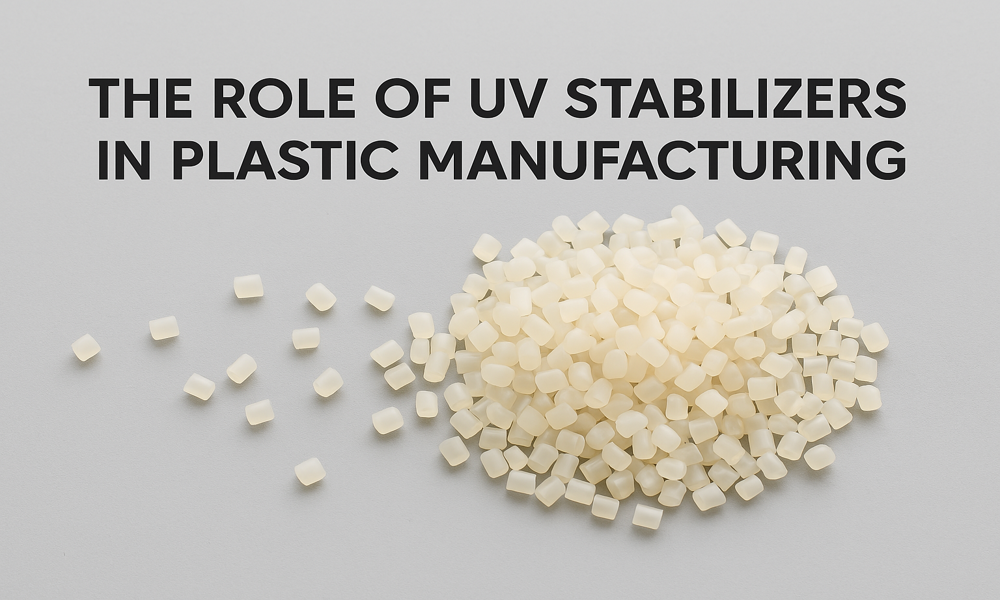The Role of UV Stabilizers in Plastic Manufacturing
The Role of UV Stabilizers in Plastic Manufacturing
In plastic manufacturing, ensuring the durability and longevity of plastic products is crucial, especially when exposed to harsh environmental conditions like UV radiation. Ultraviolet (UV) light can cause significant degradation in plastic materials, leading to fading, cracking, and reduced performance. UV stabilizers play a vital role in mitigating these effects. In this blog post, we’ll explore what UV stabilizers are, how they work, their importance in plastic durability, their applications across various industries, and the benefits of using UV-resistant masterbatches.
What Are UV Stabilizers?
UV stabilizers are additives incorporated into plastic materials to protect them from the harmful effects of ultraviolet (UV) radiation. These stabilizers absorb or block UV light, preventing it from penetrating the plastic and causing molecular damage. Without UV protection, plastics exposed to sunlight over time may degrade, leading to brittleness, discoloration, and overall loss of functionality.
UV stabilizers are commonly added in the form of UV-resistant masterbatches, which are concentrated mixtures of UV stabilizers and resins. These masterbatches are mixed with the base polymer during the manufacturing process to create plastic products that have enhanced resistance to UV-induced damage. How Do UV Stabilizers Work? UV stabilizers work by either absorbing UV radiation or converting it into harmless energy, thus preventing it from causing harm to the plastic. The stabilizers are typically categorized into two main types:
-
UV Absorbers: These stabilizers absorb UV light in the 290-400 nm wavelength range, preventing it from reaching the polymer. The absorbed energy is then either converted into heat or re-emitted as visible light, avoiding damage to the plastic structure.
-
Hindered Amine Light Stabilizers (HALS): HALS are a type of UV stabilizer that acts by neutralizing free radicals formed when plastics are exposed to UV light. Free radicals can break down the polymer chains, leading to degradation. HALS stabilize the polymer by scavenging these free radicals, effectively prolonging the life of the plastic material.
Importance of UV Stabilizers in Plastic Durability
The primary function of UV stabilizers is to prolong the lifespan of plastic materials exposed to sunlight or other sources of UV radiation. Plastics, when left unprotected, tend to degrade due to prolonged exposure to UV rays. Here’s why UV stabilizers are essential:
-
Prevents Degradation: UV rays can break down the molecular structure of plastics, leading to embrittlement, cracking, and the loss of mechanical properties. UV stabilizers help protect the integrity of the plastic, preventing these negative effects and ensuring long-lasting durability.
-
Maintains Aesthetic Quality: Over time, UV exposure can cause plastics to discolor, often turning them yellow or fading in color. UV stabilizers preserve the aesthetic appearance of plastic products, ensuring they retain their original color for extended periods.
-
Improves Performance: Plastics exposed to UV rays can lose their strength and flexibility. By adding UV stabilizers, manufacturers can enhance the material’s mechanical properties, making it more resistant to wear and tear.
Applications of UV Stabilizers Across Industries
UV stabilizers have widespread applications in various industries, particularly those where plastic products are exposed to outdoor environments. Below are some key industries that benefit from UV-resistant plastics:
1. Packaging Industry
In the packaging industry, UV stabilizers are essential for products that are used outdoors or in environments with high UV exposure. UV stabilizers help prevent packaging materials, such as bottles, containers, and films, from degrading due to sunlight. This is particularly important for food and beverage packaging, where discoloration can impact the product’s appearance and consumer appeal.
2. Automotive Industry
The automotive industry uses plastics in various exterior components, such as bumpers, trim, and dashboards. These parts are exposed to intense sunlight, which can cause fading and cracking. UV stabilizers are used to protect these parts, maintaining their appearance and functionality over time.
3. Construction and Building Materials
Building materials such as pipes, roofing, and siding are often made from plastic. These materials are exposed to harsh outdoor conditions, including UV radiation. UV stabilizers ensure that these materials retain their strength, flexibility, and appearance, even after prolonged exposure to the sun. This is especially critical for applications like piping, which needs to maintain its integrity to avoid leaks and damage.
4. Consumer Goods
UV stabilizers are also used in the production of various consumer goods, including outdoor furniture, garden tools, and toys. These products need to withstand UV exposure to ensure they don’t deteriorate or lose their color when exposed to sunlight. UV stabilizers help extend the life of these items, improving their longevity and ensuring they remain safe and attractive for consumers.
5. Textiles and Fabrics
UV stabilizers are frequently used in textiles and fabrics, especially for outdoor applications such as awnings, upholstery, and clothing. Fabrics treated with UV stabilizers are more resistant to fading and deterioration, providing consumers with products that remain durable and aesthetically pleasing over time.
Benefits of Using UV-Resistant Masterbatches
UV-resistant masterbatches offer several benefits that enhance the overall performance and longevity of plastic products. These include:
1. Enhanced Durability
By incorporating UV stabilizers into plastic materials, manufacturers can significantly increase the lifespan of the product. UV stabilizers protect against UV-induced degradation, making the plastic more resistant to weathering, cracking, and fading.
2. Cost-Effectiveness
Although adding UV stabilizers may incur additional costs during the manufacturing process, it ultimately helps to reduce costs related to product replacement or repairs. By extending the product’s useful life, manufacturers can offer consumers high-quality, long-lasting products that require minimal maintenance.
3. Improved Aesthetic Appeal
UV stabilizers maintain the appearance of plastic products by preventing discoloration and fading caused by UV exposure. This is especially important for products that are exposed to direct sunlight, where maintaining a visually appealing product is essential for consumer satisfaction.
4. Environmental Protection
UV stabilizers not only protect the physical properties of plastics but also help in promoting sustainability. By ensuring that plastic products last longer, UV stabilizers reduce the need for frequent replacements and waste, contributing to more environmentally-friendly plastic usage.
5. Versatility in Application
UV-resistant masterbatches can be used in a variety of plastic products across different industries, offering flexibility in terms of product design and application. Whether for automotive parts, packaging, or textiles, UV stabilizers enhance the functionality of the final product.
Conclusion
UV stabilizers are essential additives in plastic manufacturing, playing a key role in improving the durability and longevity of plastic products exposed to UV radiation. By preventing degradation, discoloration, and loss of mechanical properties, UV stabilizers ensure that plastic products maintain their performance and appearance over time. Their applications span across industries, from packaging and automotive to construction and consumer goods. The use of UV-resistant masterbatches provides significant benefits, including enhanced durability, cost-effectiveness, and improved aesthetic appeal. As UV exposure continues to pose a challenge to plastic materials, the role of UV stabilizers becomes increasingly vital for creating long-lasting, high-quality products.


